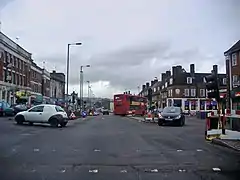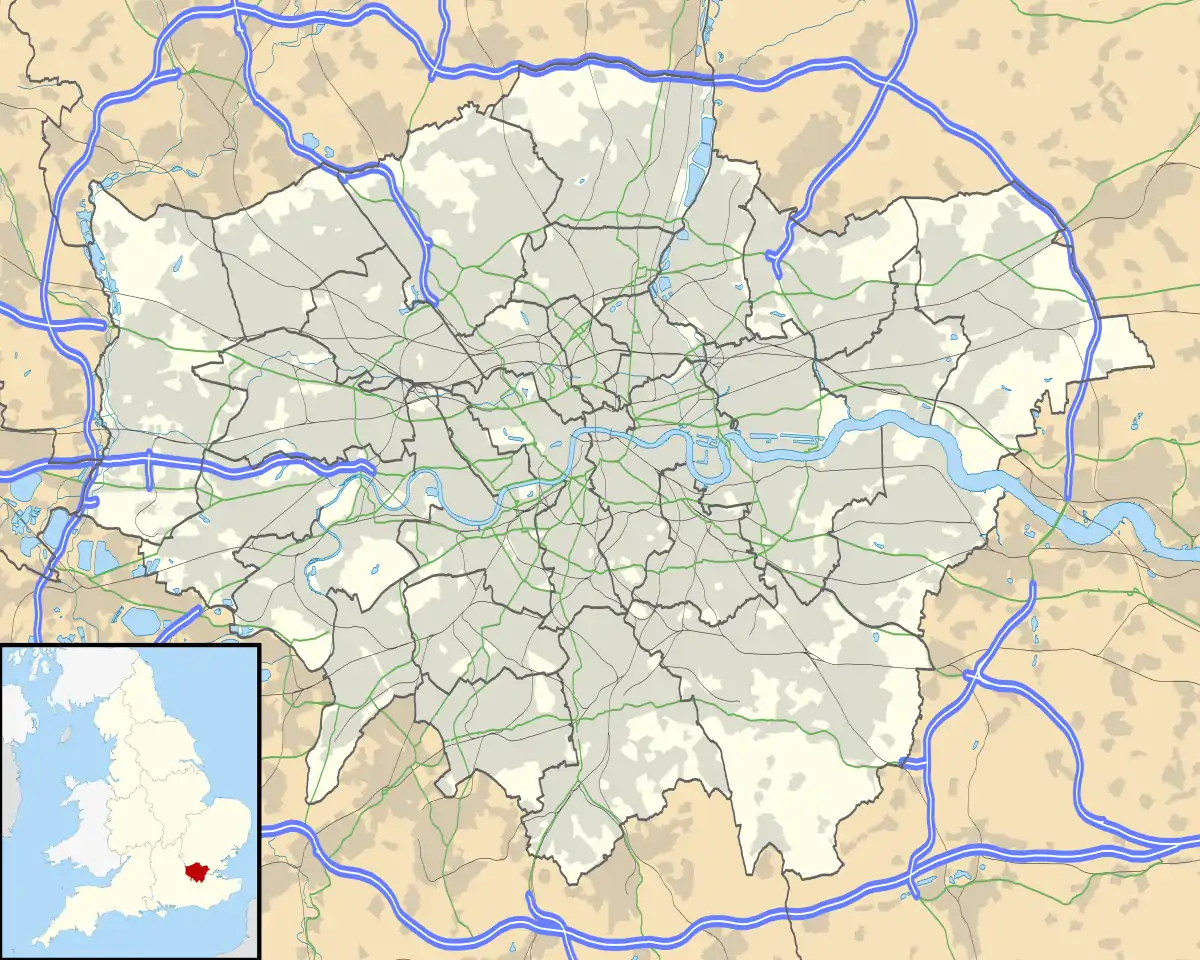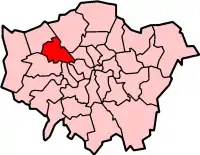Burnt Oak
Burnt Oak is a suburb in the Edgware district in northwest London, England. It lies to the west of the M1 motorway between Edgware and Colindale, in the London Borough of Barnet. The western part of the Edgware Road (locally Burnt Oak Broadway) lie partly in the London Borough of Brent and London Borough of Harrow;[1] the border formed by Watling Street. It was part of Middlesex until it was transferred to Greater London in 1965.
| Burnt Oak | |
|---|---|
 Burnt Oak Broadway | |
 Burnt Oak Location within Greater London | |
| OS grid reference | TQ205915 |
| • Charing Cross | 9.6 mi (15.4 km) |
| London borough | |
| Ceremonial county | Greater London |
| Region | |
| Country | England |
| Sovereign state | United Kingdom |
| Post town | EDGWARE |
| Postcode district | HA8 |
| Dialling code | 020 |
| Police | Metropolitan |
| Fire | London |
| Ambulance | London |
| UK Parliament | |
| London Assembly | |
History
.jpg.webp)
The name Burnt Oak was first used in 1754[2] and from then until the 1850s referred to no more than a field on the eastern side of the Edgware Road (Watling Street). Nor is there evidence that the name implies anything except that the field had once contained a burnt oak tree. In May 1844 Burnt Oak field was sold to a Mr Essex, and by the 1860s plans were in place to build three residential streets: North Street, East Street, and South Street. The application of the field name to the area seems to have followed from this new estate and was in use by the end of the 19th century. However, the area was generally known as Red Hill until the opening of Burnt Oak tube station.
There were a handful of shops by the 1890s. There was a post office and grocery run by George and William Plumb, a bakery run by Caller & Poole, as well as James Huggett the greengrocer. A tramway along the Edgware Road to Cricklewood opened in 1905, but the population remained small, by 1921 still only around 1,000.
Burnt Oak station on the London Underground's Northern line opened on 27 October 1924. It was first open on weekdays with a small booking hall suitable for a rural area. As it was on farmland south-east of the community in Edgware Road, Underground Electric Railways Company of London constructed a new road, Watling Avenue. In the same year news leaked out that the London County Council was to build a housing estate (Watling Estate), which was ready for its first occupants in April 1927.[3] With this and other private estates the area was provided with a new station by 1928, and the population by 1931 had grown to 21,545. Along both sides of Watling Avenue shops were built along with a number of schools to serve the area, such as Woodcroft and Goldbeaters.
In September 1931 Jack Cohen opened the first Tesco store at 54 Watling Avenue, Burnt Oak.[4][5][6]
In 1930, Dominican nuns established St Rose's Convent on Orange Hill Road, which led to the foundation of St James' Catholic High School in 1934. In 1936 Watling Market opened with a hundred covered shops and stalls, and the Co-op opened its department store at the junction of Stag Lane and Burnt Oak Broadway (now a Peacocks). [7]
Watling Estate
The Watling Estate is one of 12 London County Council cottage estates built between the wars to provide Homes fit for Heroes.[3]
| Estate name | Area | No of dwellings | Population 1938 | Population density |
|---|---|---|---|---|
| Pre-1914 | ||||
| Norbury | 11 | 218 | 867 | 19.8 per acre (49/ha) |
| Old Oak | 32 | 736 | 3519 | 23 per acre (57/ha) |
| Totterdown Fields | 39 | 1262 | — | 32.4 per acre (80/ha) |
| Tower Gardens White Hart Lane | 98 | 783 | 5936 | 8 per acre (20/ha) |
| 1919–1923 | ||||
| Becontree | 2770 | 25769[lower-alpha 1] | 115652 | 9.3 per acre (23/ha) |
| Bellingham | 252 | 2673 | 12004 | 10.6 per acre (26/ha) |
| Castelnau | 51 | 644 | 2851 | 12.6 per acre (31/ha) |
| Dover House Estate Roehampton Estate | 147 | 1212 | 5383 | 8.2 per acre (20/ha) |
| 1924–1933 | ||||
| Downham | 600 | 7096 | 30032 | 11.8 per acre (29/ha) |
| Mottingham | 202 | 2337 | 9009 | 11.6 per acre (29/ha) |
| St Helier | 825 | 9068 | 39877 | 11 per acre (27/ha) |
| Watling | 386 | 4034 | 19110 | 10.5 per acre (26/ha) |
| Wormholt | 68 | 783 | 4078 | 11.5 per acre (28/ha) |
| 1934–1939 | ||||
| Chingford[lower-alpha 2] | 217 | 1540 | — | 7.1 per acre (18/ha) |
| Hanwell (Ealing) | 140 | 1587 | 6732 | 11.3 per acre (28/ha) |
| Headstone Lane | 142 | n.a | 5000 | |
| Kenmore Park | 58 | 654 | 2078 | 11.3 per acre (28/ha) |
| Thornhill (Royal Borough of Greenwich) | 21 | 380 | 1598 | 18.1 per acre (45/ha) |
| Whitefoot Lane (Downham) | 49 | n.a | n.a. | |
| Source:*Yelling, J.A. (1995). "Banishing London's slums: The interwar cottage estates" (PDF). Transactions. London and Middlesex Archeological Society. 46: 167–173. Retrieved 19 December 2016. Quotes: Rubinstein, 1991, Just like the country. |
|
Geography
Demography and culture
The 2011 census showed that for the Burnt Oak ward in Barnet, 47% of the population was white (30% British, 14% Other, 3% Irish). 13% was Black African and 12% Other Asian. Religiously, 50% was Christian, 18% Muslim, 7% Hindu, 2% Buddhist and 1% Jewish.[8]
The area is known for its variety of multicultural shops, reflecting the established Indian, Turkish and Nigerian communities. It has recently also attracted a community of Eastern Europeans, mainly from Romania, Poland and Bulgaria. The relatively large size of the Romanian community has earned Burnt Oak the nickname "Little Romania".[9][10]
Transport

Burnt Oak is well served by buses. London Buses routes 32, 114, 142, 204, 251, 292, 302, 305, and Uno routes 614 and 644 all meet at the junction of Watling Avenue, Stag Lane and Burnt Oak Broadway. The old route 52 was split into a shorter 52 (between Willesden Junction and Victoria bus station and new route 302 (from Mill Hill Broadway to Kensal Rise via Burnt Oak) in 1992. Night bus route N5 runs between Trafalgar Square and Edgware bus station serving all the tube stations, and the N16 runs north from Victoria Station via the Edgware Road, to Edgware Station, via Burnt Oak.
Northern line trains on the Edgware Branch serve Burnt Oak tube station.
References
| Wikimedia Commons has media related to Burnt Oak. |
- https://www.harrow.gov.uk/downloads/file/26937/characterisation-study-of-harrow-2011
- Weinreb, Ben; Hibbert, Christopher; Keay, Julia; and Keay, John (2011). The London Encyclopaedia (3rd edition), p. 116. Pan Macmillan. Retrieved 1 May 2014.
- Appraisal 2007.
- Maurice Corina: Pile It High Sell It Cheap: The Authorised Biography of Sir Jack Cohen, Weidenfeld & Nicolson, London, 1971
- Andrew Hosken: Nothing Like a Dame: The Scandals of Shirley Porter, Granta, 2007
- Sarah Ryle: The Making of Tesco: A story of British Shopping, Random House, 2013
- Just like the country(b) 1991.
- "Burnt Oak". UK Census Data.
- https://metro.co.uk/2018/06/01/romanian-baker-wont-employ-brits-dont-work-hard-enough-7596823/
- https://www.mylondon.news/news/west-london-news/visited-londons-little-romania-asked-15676028
- Bibliography
- "Watling Estate Character Appraisal" (PDF). Barnet: London Borough. 2007. Archived from the original (PDF) on 9 October 2015. Retrieved 28 December 2016.
- Rubinstein, Antonia; Andrews, Andy; Schweitzer, Pam (1991). "Just like the country part 2" (PDF). Age Exchange. Retrieved 17 December 2016. Cite journal requires
|journal=(help)

